September 11, 2016
Martha O'Kennon
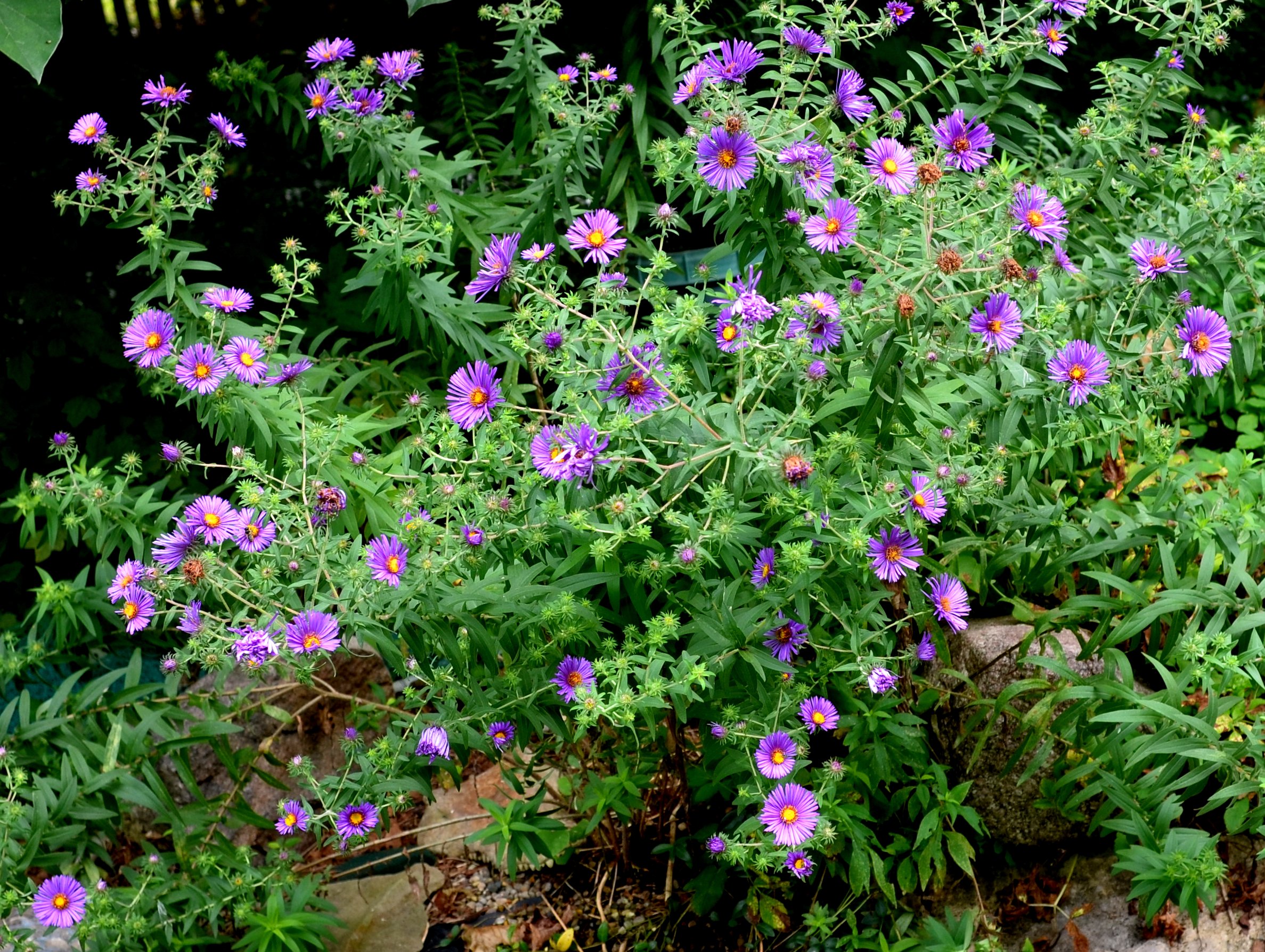

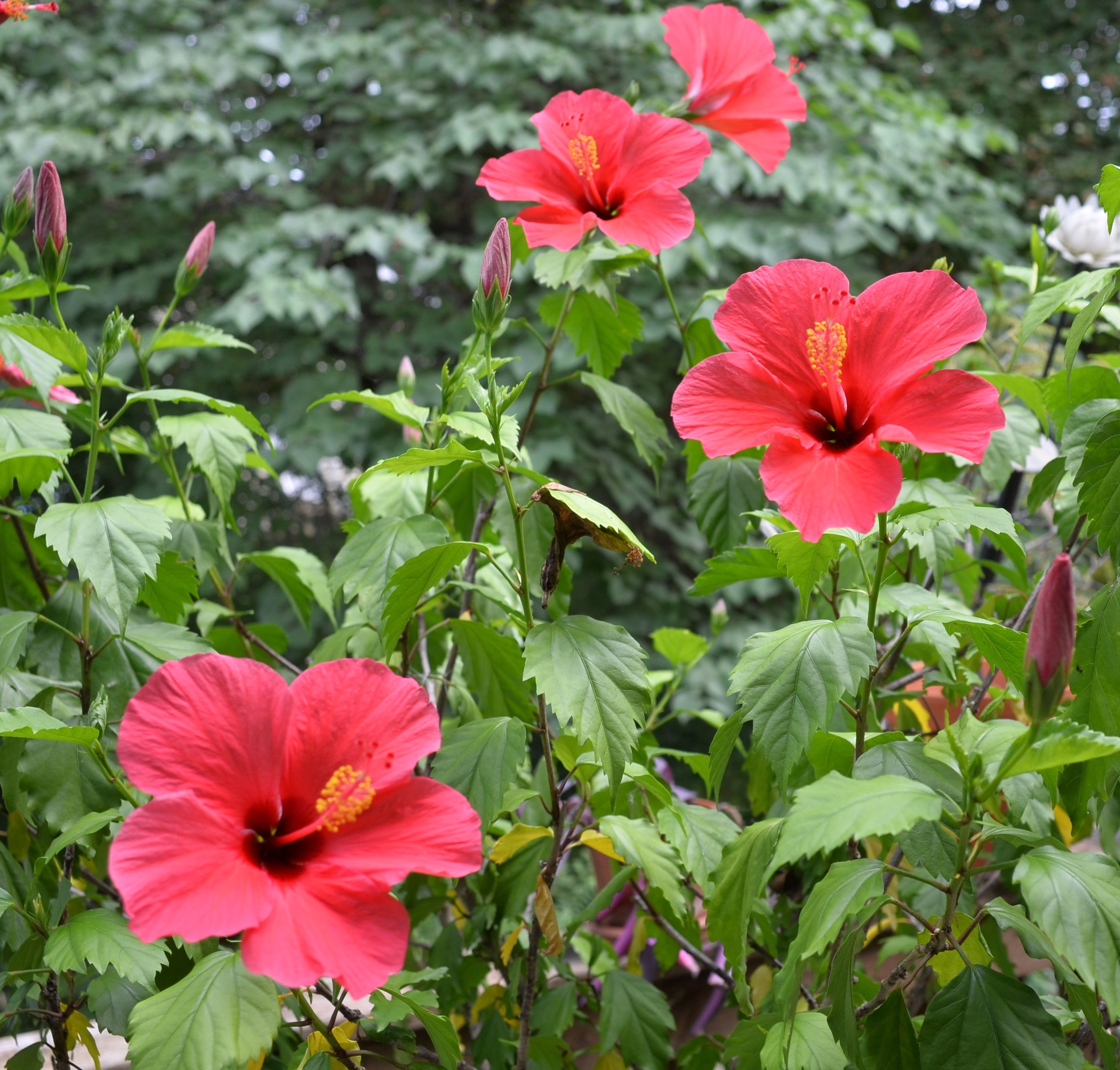
It's not cool! The air conditioning is back on for the duration. Meanwhile, the purple asters in the back yard are fully blooming while the ones more in the shadows are only beginning to show some colors. Unfortunately, this wonderful (I mean it: I point and it shoots) camera cannot resolve things like that mysterious bug on one of the flowers a little right of center and nearer the top of the picture. So we have to wait to see the hoverflies that I'm eagerly awaiting. Doesn't this Japanese anemone look as if it were enclosing that green sweat bee in its voluptuous arms? Or maybe it's imitating the Venus fly-trap? The hibiscus is telling us that it has loved all the heat and also the rain that has come a few times. I never saw it bloom so prolifically!
Remember that there is information in the name of the file for each image. You can see it by mousing over the image - look at the lower left of the screen.
I would try clicking on the image. If the little "+" sign appears, it means you can enlarge again. Whilet is in "+" mode, click on something you want to see more clearly and it will zoom to that section. Then the info is displayed in the address line above. If the image has been cropped
so that clicking on it doesn't result in a larger picture, you can always hit control-plus to increase the size of the image.
The pond is also clearing up a bit. Of course creatures are busily visiting to bring gifts of gold, frankincense and myrrh to the six or seven baby fishes. They come in all colors and sizes from an inch and a half to an inch. I have to buy some more fishfood to coax them out. (Your raccoons opened and emptied the last can.) Then maybe I can get you some pictures. They are so incredibly cute but somehow know how to act like fish. Well, you are probably wondering where are the token ant pictures? There weren't any. I spent a whole week in goldenrod land. Scattered around the yard are some small and some medium-sized goldenrod patches. It is both a gorgeous yellow color but invites so many things that I don't ordinarily get a good picture of. The predators (assassin bugs and ambush bugs, for instance) come to get the other things that come to drink goldenrod tea. How to describe it? The big music festival at Woodstock? A buttterbeer bar? Everyone wants to be there. This honeybee is in bee heaven. I just spent an hour looking at little bumblebees and have decided I met my match when they invented all the kinds of tiny bees. So this is just a "tiny bumblebee".
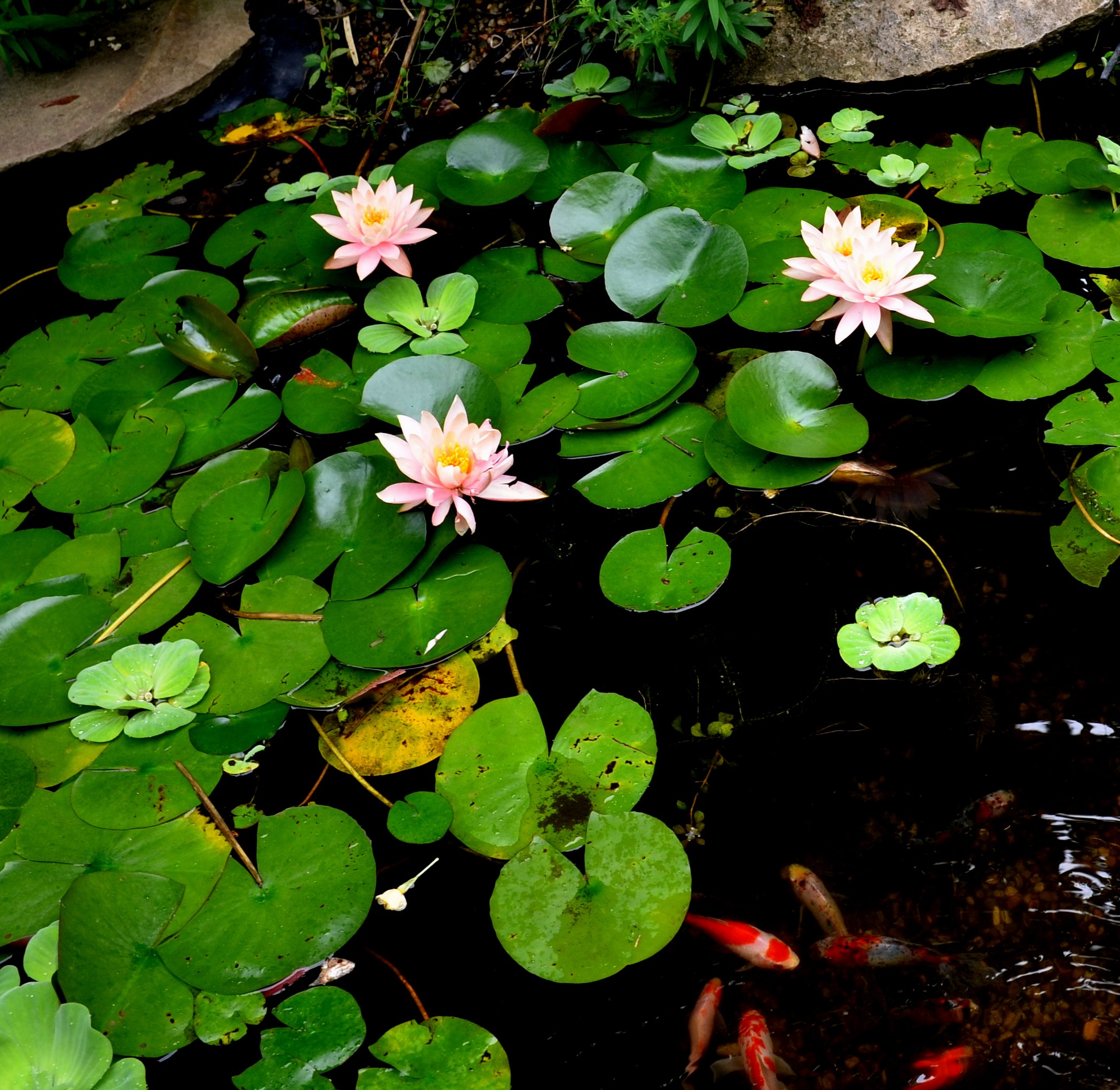

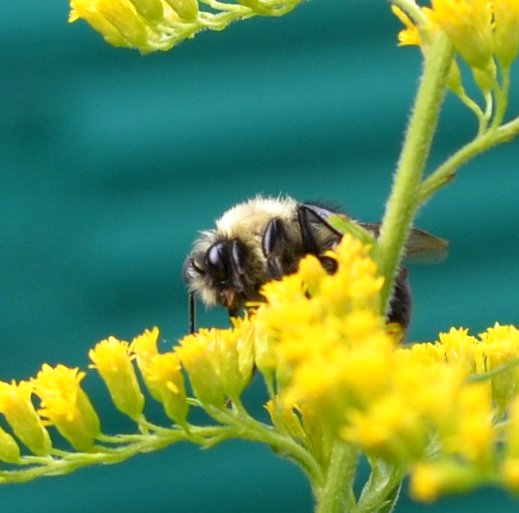
Here are a couple more mystery bees. I give up, I'll just show them to you and hope to ID them soon. The tiny one looks out over a mound of golden flowers. The scruffy one (Isn't it amazing?) (two images) is also a messy eater! I just got the report back - apparently it is the Common Eastern Bumblebee. Who would know it from all the stuff all over it?
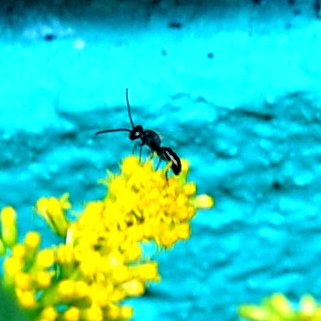


This first one is probably a Miner Bee Andrena aliciae - it's easy to spot by the pattern the pollen makes on its legs. The second, which we have seen so often, is a tiny green sweat bee, and NOT on goldenrod, although that golden goodness is a frequent place to visit.
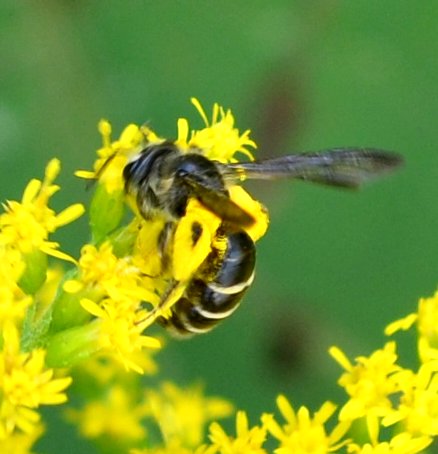
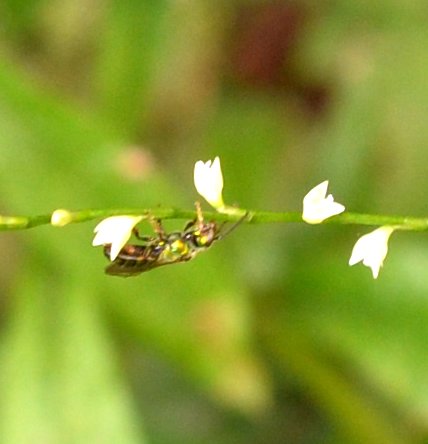
A few beetles are naturally drawn to the goldenrod. We've met the Goldenrod Soldier Beetle - here a side view and a rear view as it scurries away. We also love the Locust Borer. Here it is in a bit of shade.
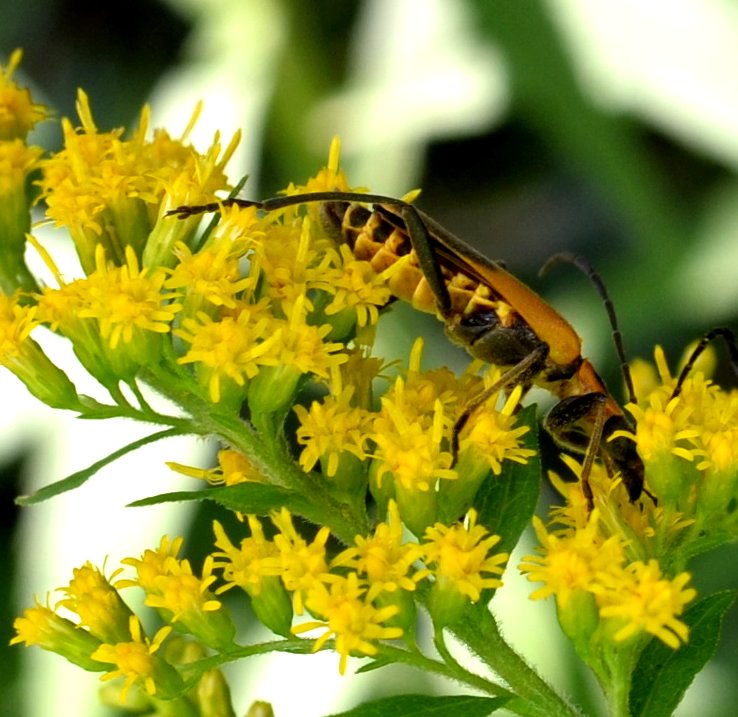

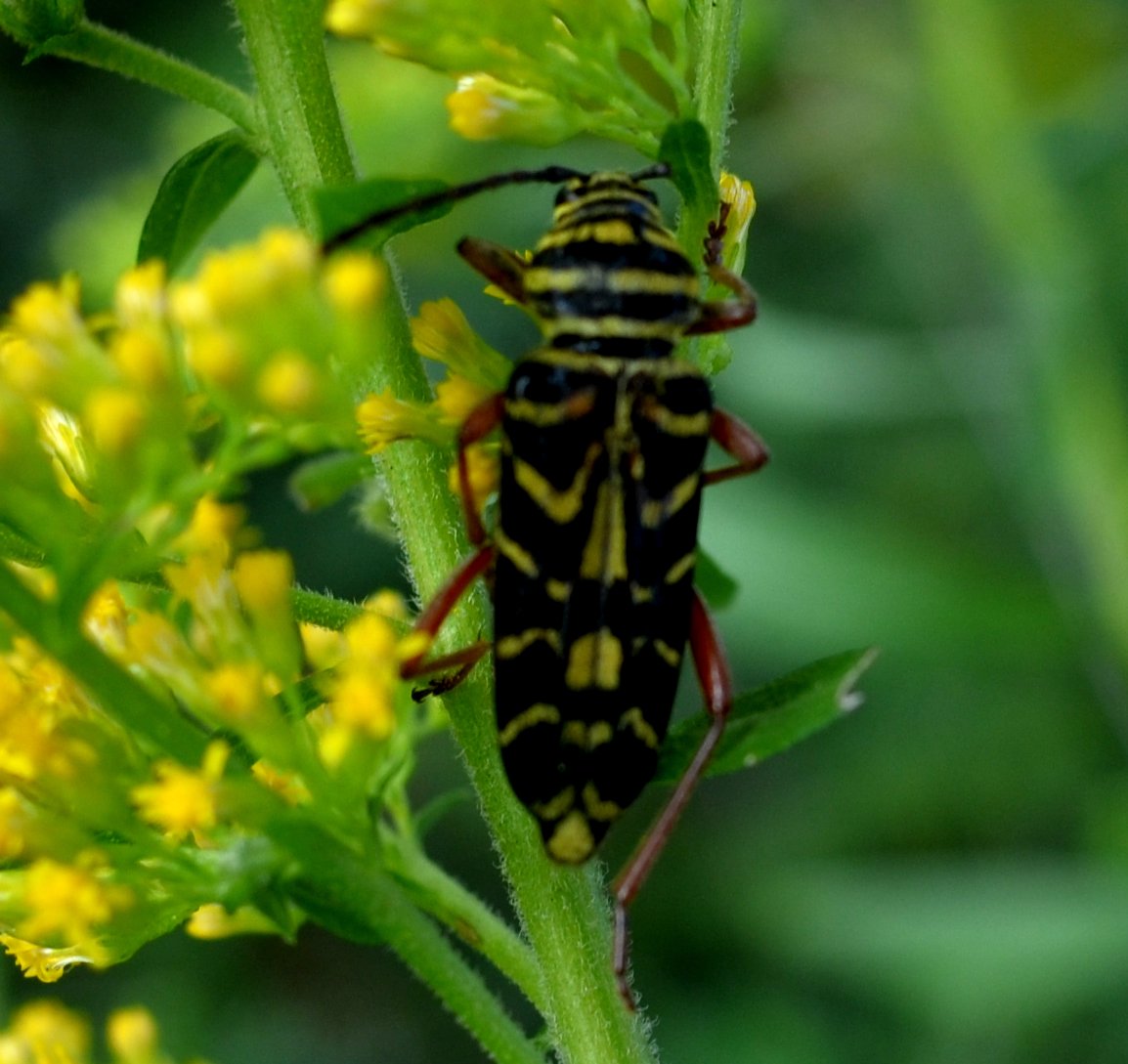
The Lady Beetles are greatly attracted to goldenrod too. Of course, they are great predators of smaller creatures, so they go where the critters are. This one is called the multicolored Asian Lady Beetle, and the next image is the Mexican Jumping Bean Beetle. Oh! Its range is most of the eastern US (and Colorado), but nowhere near Mexico! Finally, the Redbud Bruchid (remember a bruchid is a weevil that lays its eggs in developing Leguminous pods, and the resulting larvae eat the seeds inside the pod.) on one of its associated plants, the Goldenrod!
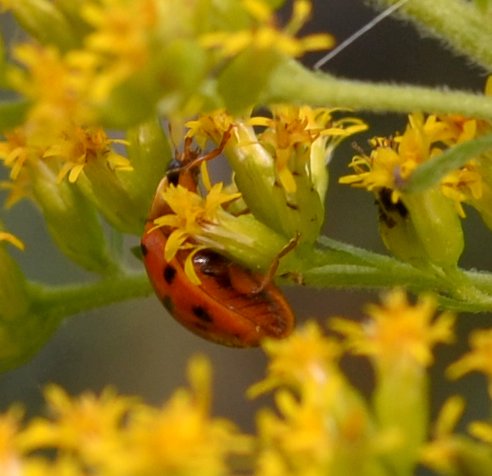
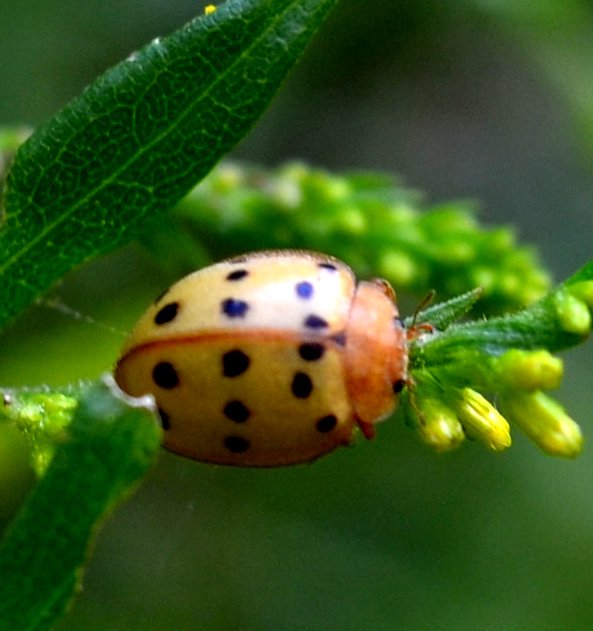

The bugs are many and of many species. The Assassin Bugs are a little over half the size they will grow into. Here is Zelus luridus, which can be seen in many color combinations from lime green to orange. Here are two different colorations. There are very few days in the summer when you can't see one size (tiny nymph) to the other (adult). The nymphs are hard not to see hunting on top of a leaf. One other kind of bug that is a descendant of the assassins is the Ambush Bug. You saw a couple of weeks the first one I ever saw. And that one I would have missed because I was focusing on the much bigger bee that one of the ambush bugs was feeding on. This week opened a new door through which the Ambush bugs came streaming, well, just one at a time. Here's one I found in the northern wastes (the area between my house and the big building to my north). He (I assume he is a male because he resembles the darkly brown bug on top of the much lighter female) had caught a bee or wasp and was in the process of scarfing it down.

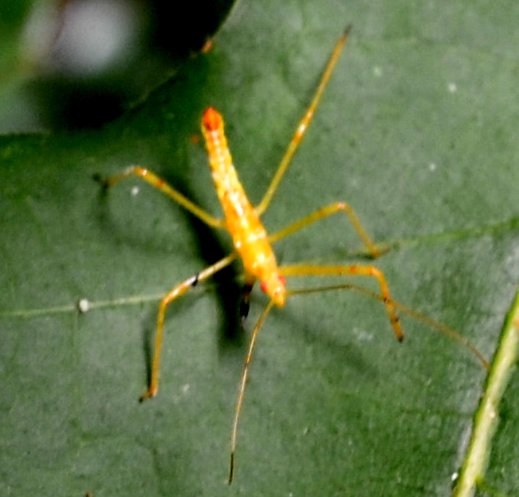
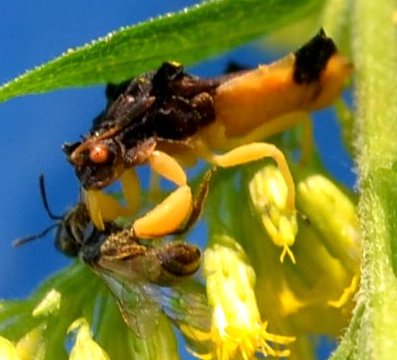
But the big surprise was on the 7th when I saw at least four different ones all on the goldenrod at various parts of the yard. On the 9th I got this picture - look how golden his appendages are. One female was so patient I got quite a few nice pictures of her. I decided that the males of Phymata pennsylvanica are darker and their claws and legs are golden, while the females are quite a bit lighter in color and have green appendages. So here are two images of the female I saw on the 7th.
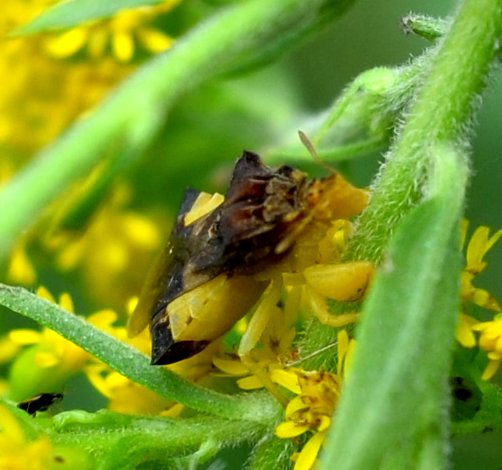
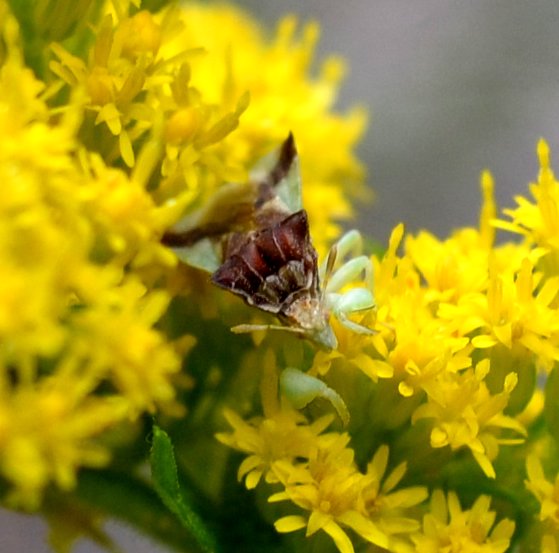
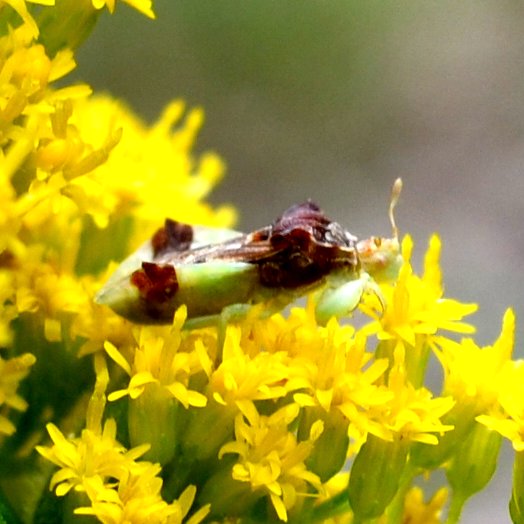
This orange bug showed up in a corner of another picture. (That's why it is nowhere near in focus and so I don't submit it to bugguide.) It could be what they show as a predatory stink bug. Those reddish stink bugs are still around, but their colors seem to be fading (or maybe darkening). Only one kind of leafhopper showed up this week - guess who! Of course, that omnipresent spittle bug is still here.
 9 9 16 2.jpg)
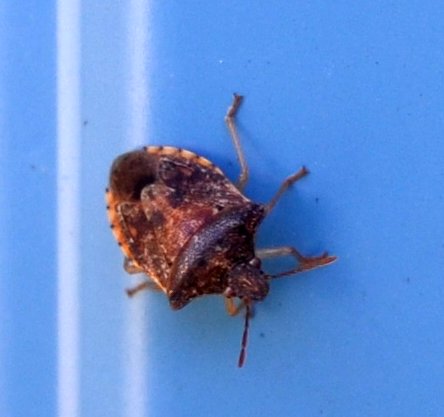
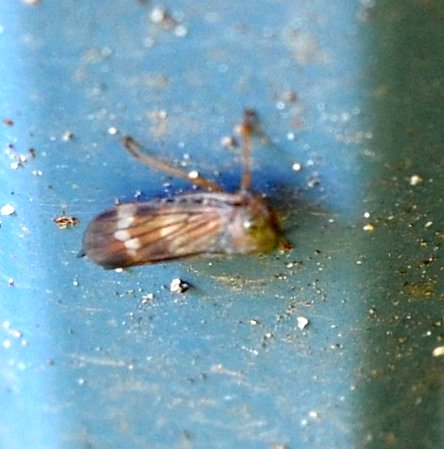
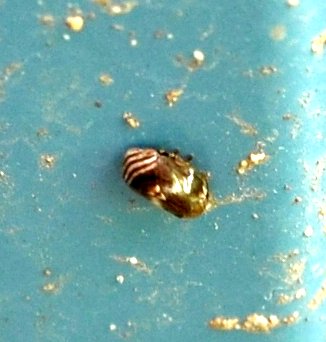
The kitty seems to think that shady spot under the Euonymus is hers. I am wondering if she is a former pet and became one of our street cats as a car zoomed down the street, braked, opened the door and voila! Another homeless cat! She seems to be polydactylic, look at those thumbs! Here's a cat, which is what caterpillar fanciers call it. It is so tiny I wouldn't have noticed it except that it was near something I WAS looking at. But look at this! The goldenrod seems to have developed an arc of flower bits.

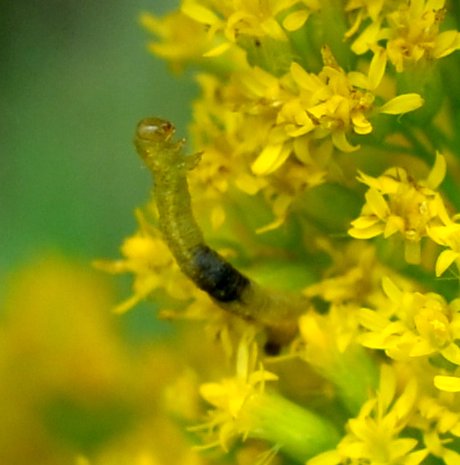
But look at this! The goldenrod seems to have developed an arc of flower bits. While I was pondering this strange growth on the goldenrod, it twitched at one end. A tiny head poked out as it kept moving along. At this point, its whole body seems to stretch into existence. I didn't know such a creature existed - the inchworm was using bits of flowers to disguise itself.


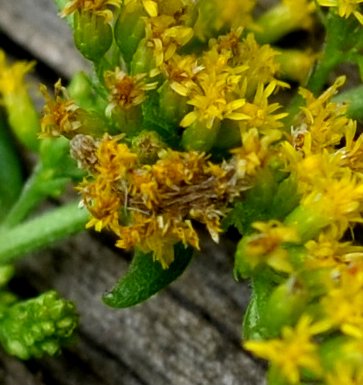
Here's a devoted mother (go back to the last issue) earwig; a possible gnat; Some time ago I thought this was a bee. But no bees popped up in a search for a black bee with reddish wings. Finally after an hour or two of looking I saw the eyes. Even from behind, they look like fly eyes. Click on it to see another view - of course it's a fly (one of the Lance Flies - family Lonchaeidae)!
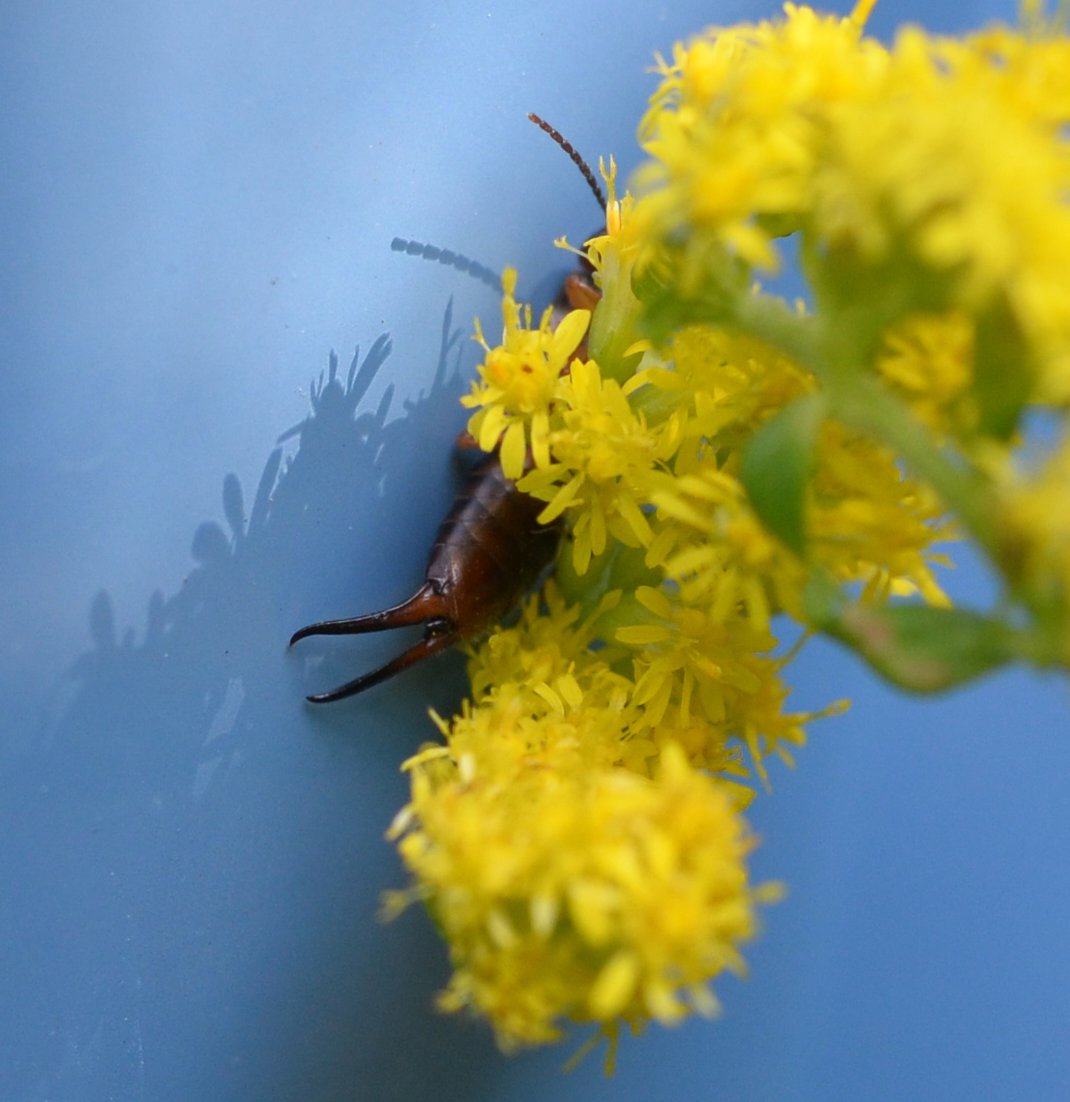

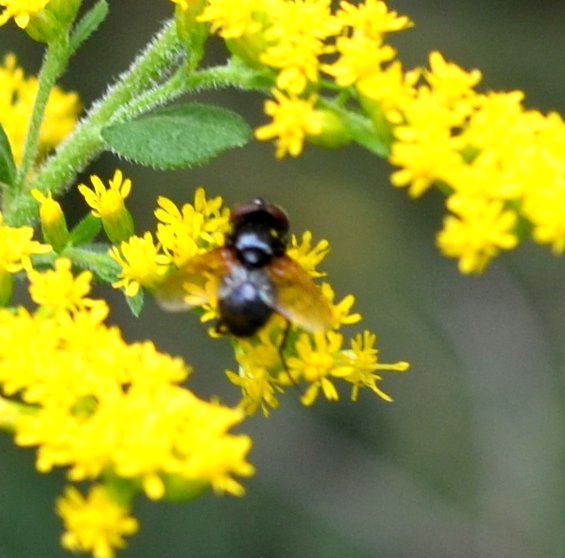
Here is a long-legged fly, chosen for funky face rather than goodness of shot. The next image is one of the fruit flies - but how lovely! And lastly, a familiar-looking fly right in the center of the hosta - looks like one of the flesh-eating flies.
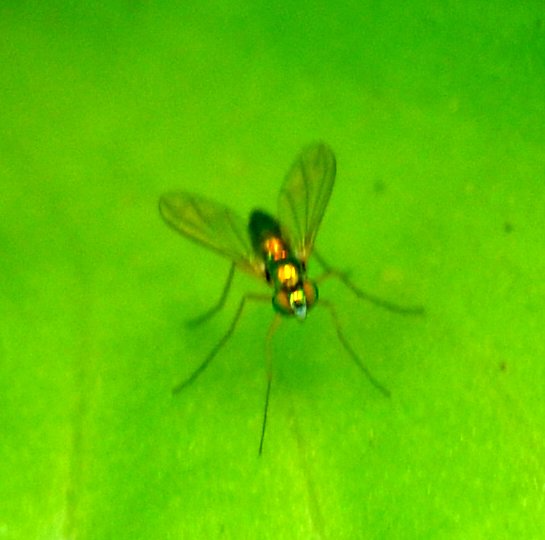
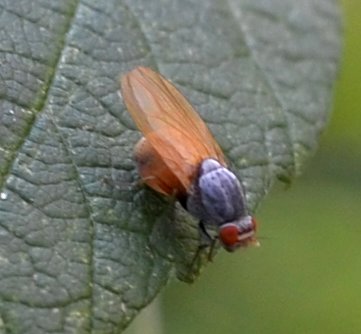
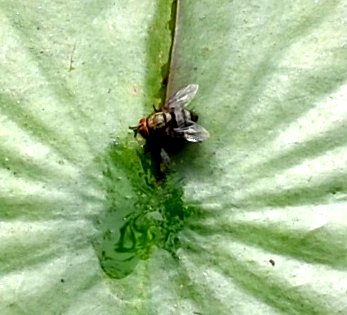
Here are some of this week's mosquitoes. This first one is some member of the genus Ochlerotatus; the second my favorit photo so far of our beloved Psorophora ferox; and third, another view of P, ferox - what? It's not blue! Well, in this light it looks bluish. But it has the dead giveaway white socks on the back legs. Note: the bluish one seems to be a male as it is lacking the sword that all the females have. None of these pretty mosquitoes has bitten me. The culprits are very tiny, maybe 3 mm long, but what they lack in size, they make up for in quantity. So far, huge quantities of Deet have helped keep them off - mostly. Even though I cover my face with it, some of those little monsters try for the soft stuff underneath my glasses, and anywhere else the sweat has washed off the Deet. Have you any idea how hard it is to aim a camera at the enemy when it is on your hands?
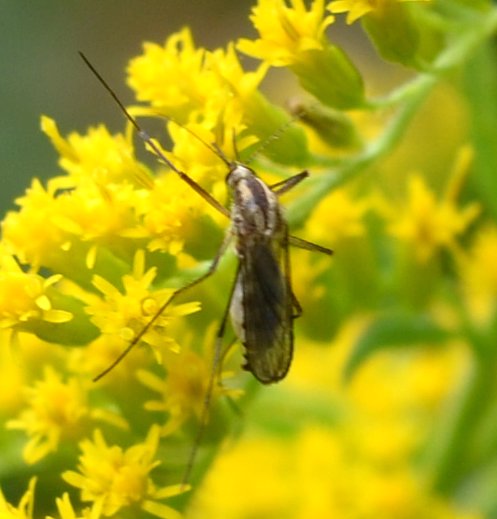
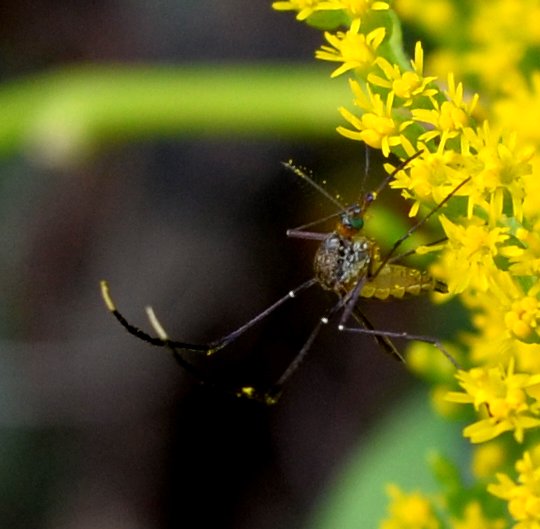
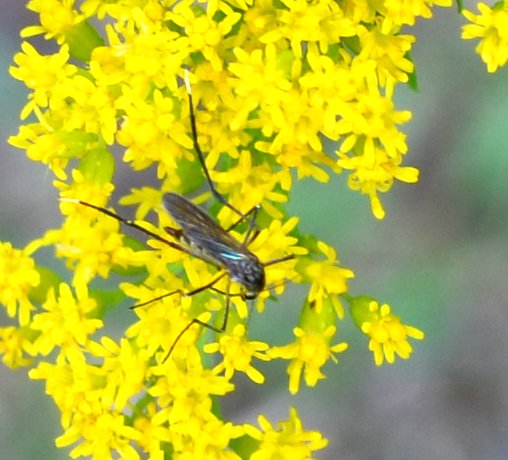
Now we see what has to be a hover fly in various poses. There is a rumor that although hover flies love to visit flowers (I'm waiting for them to come to my asters once the asters get a good start), they may not be so good at pollinating as bees. Their bodies are less hairy and so most of them don't have good places for pollen to collect. Here's an article by a hover fly lover and here's one by the Forest Service. Conclusion: some are good pollinators, and some aren't.
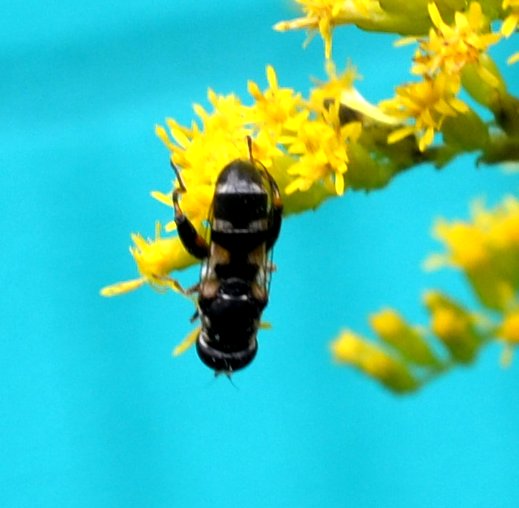
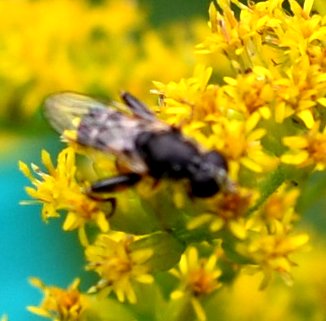
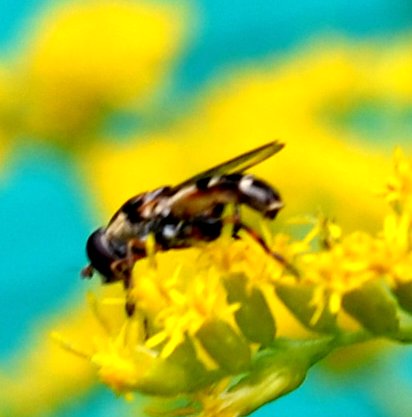
Here are a few images of just pleasant scenes botanical. Here is the geranium that my friend Sue gave me. This winter I kept feeding it although it seemed to need the nap. Now it greets you as you come up the step. Would anyone like to hazard a guess at what this black thing emanating from the goldenrod might be? And - the pinkish mauve asters are beginning to blossom? My favorites! And sure to be the favorite place for flies and bees to come pose for their selfies. Soon...

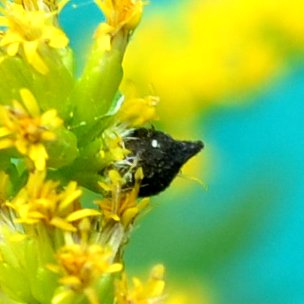
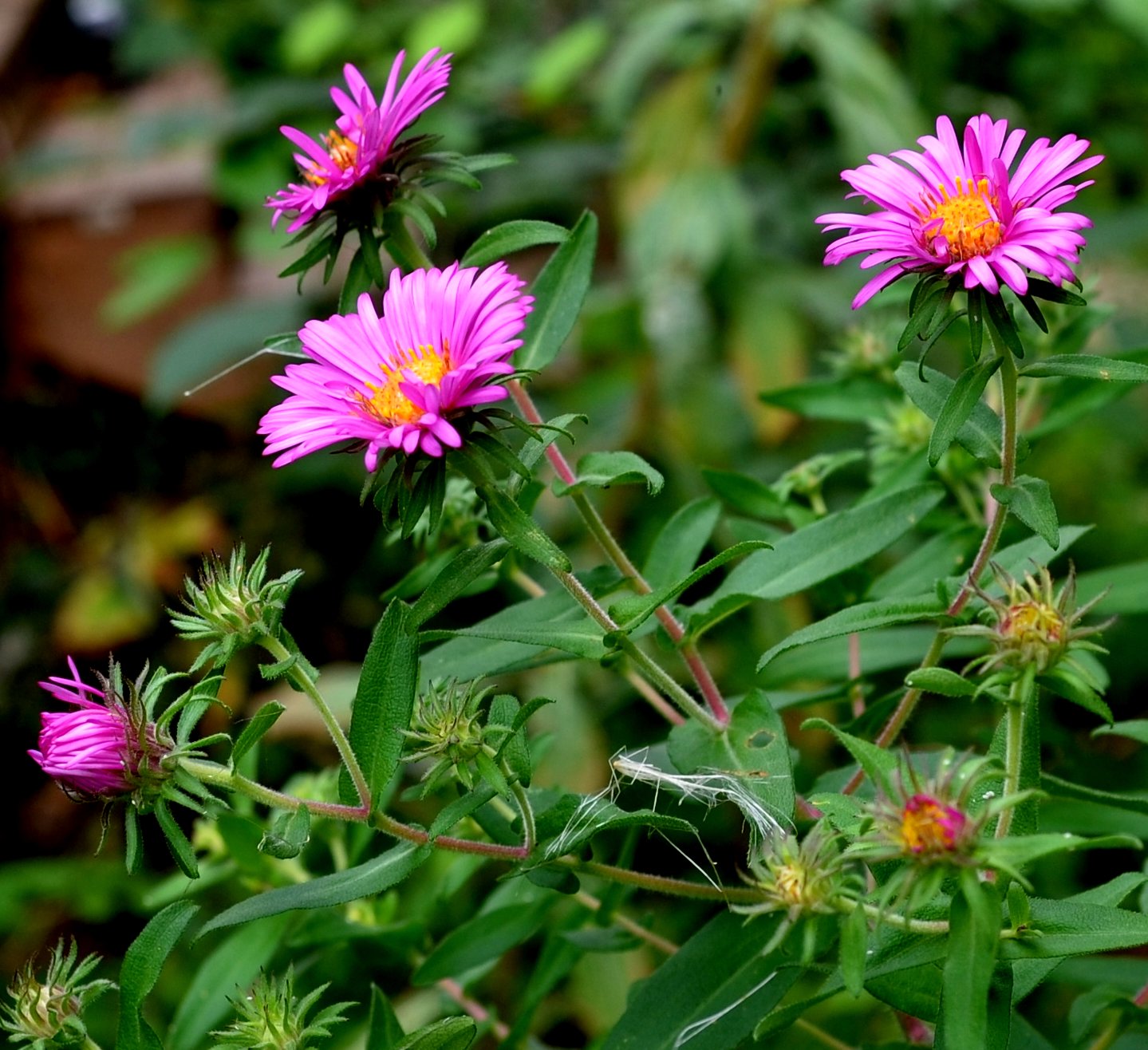
Now back to the menagerie. The scorpion fly is a little harder to find but I still manage to find one each day or two. The harvestmen are still quite beautiful now. And so hungry!
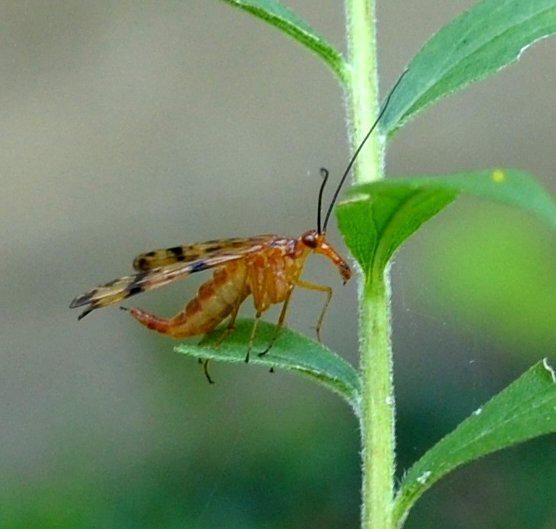
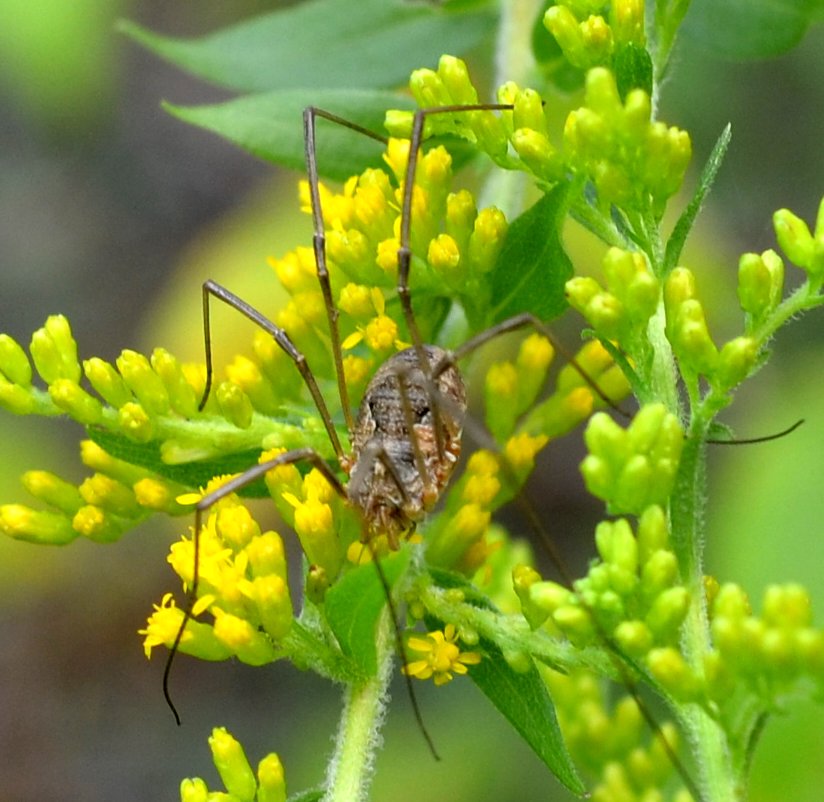
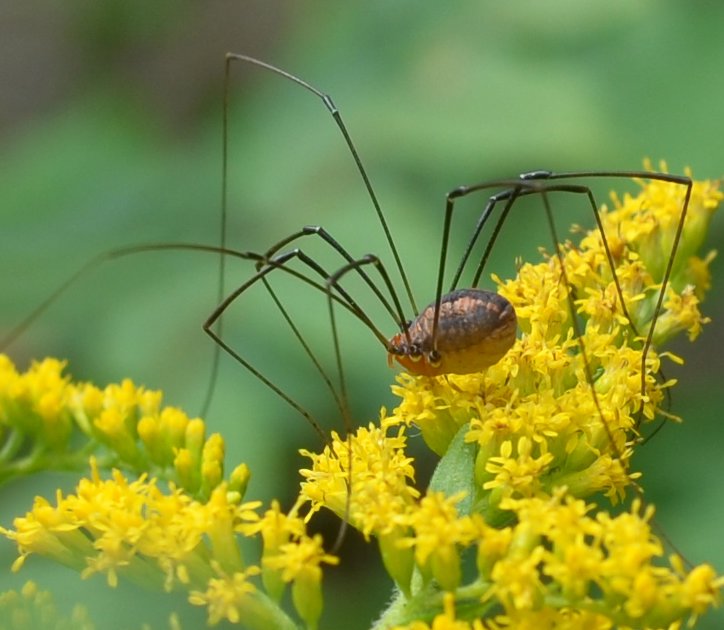
These two moths are NOT the same. Their overall wing shapes are very similar, but their patterns are different. I especially like the second one in this row.
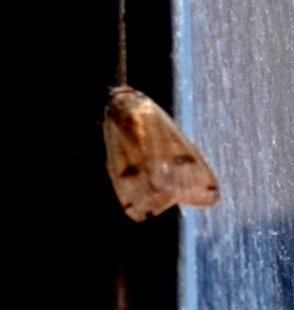
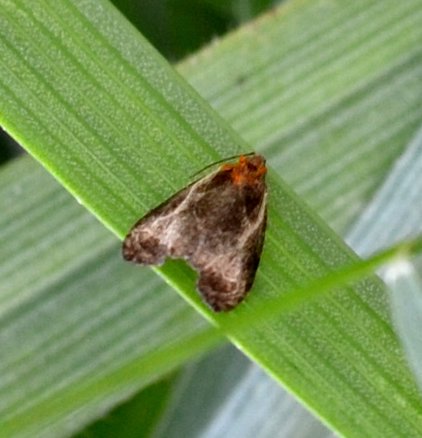
The nightshade is delicate and lovely, what's left of it after I released 7 hornworm caterpillars into it. Now it's mostly under control.

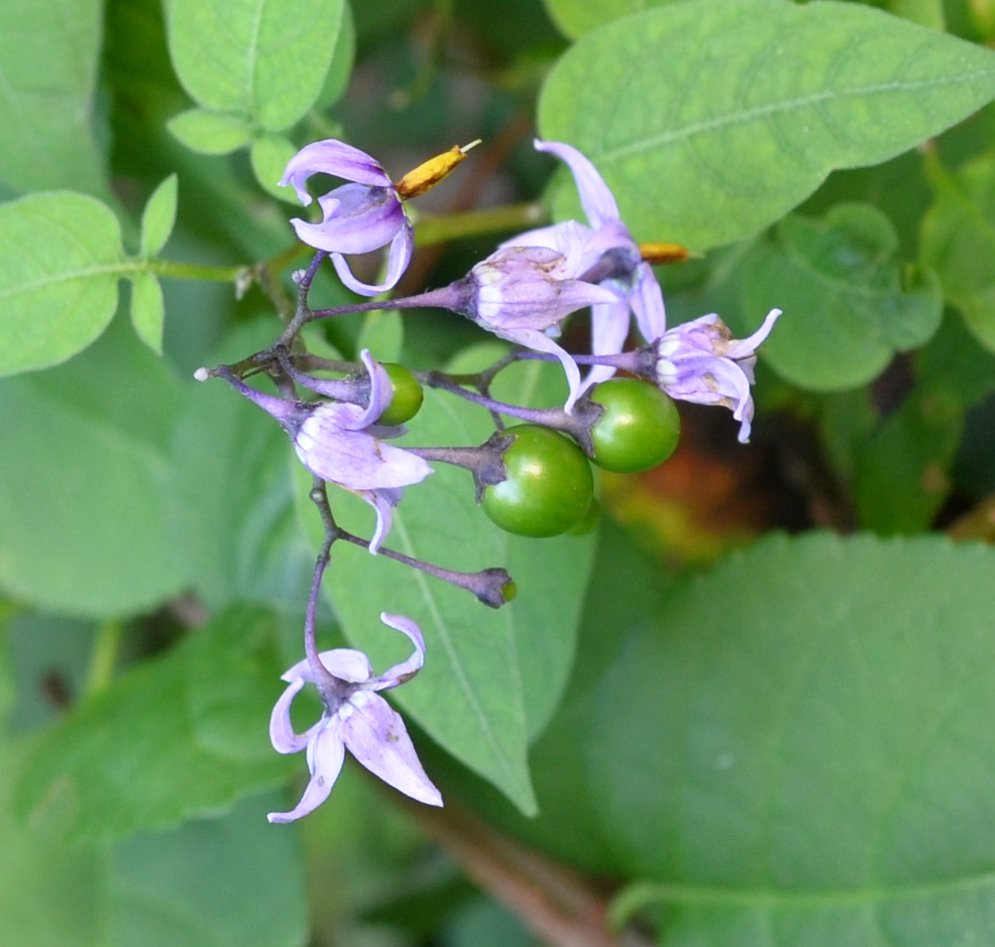
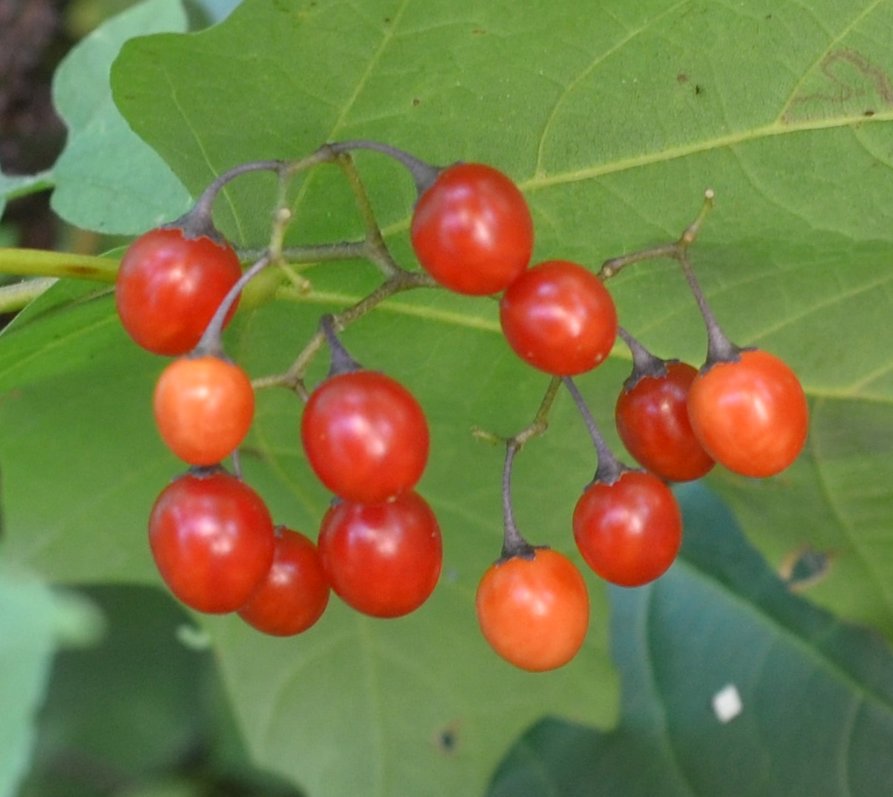
I was opening the GFI box to turn off the pump to the pond, and out came this large brown cricket. I didn't recognize it so sent it in to Bugguide.net. It turns out to be a female Jumping Bush Cricket - and this reminded me that I had submitted that very kind of insect LAST year in NOVEMBER. That was in the midst of the time last year when most insects should have died off or secreted themselves under the house or underground.
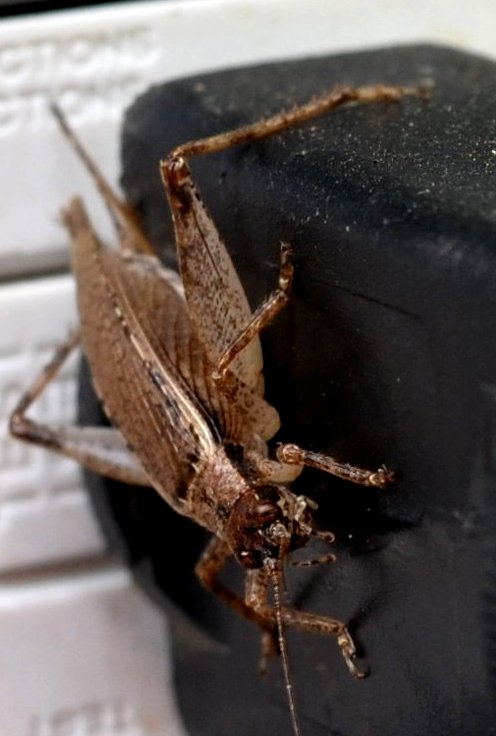
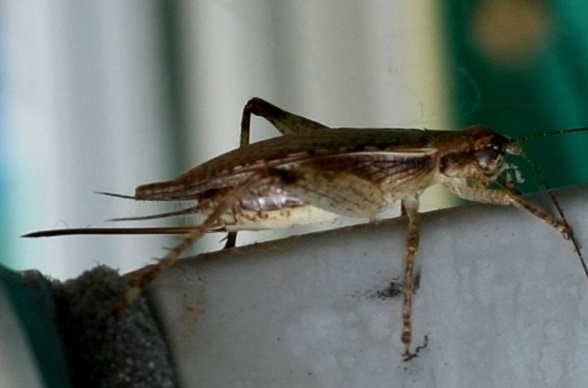
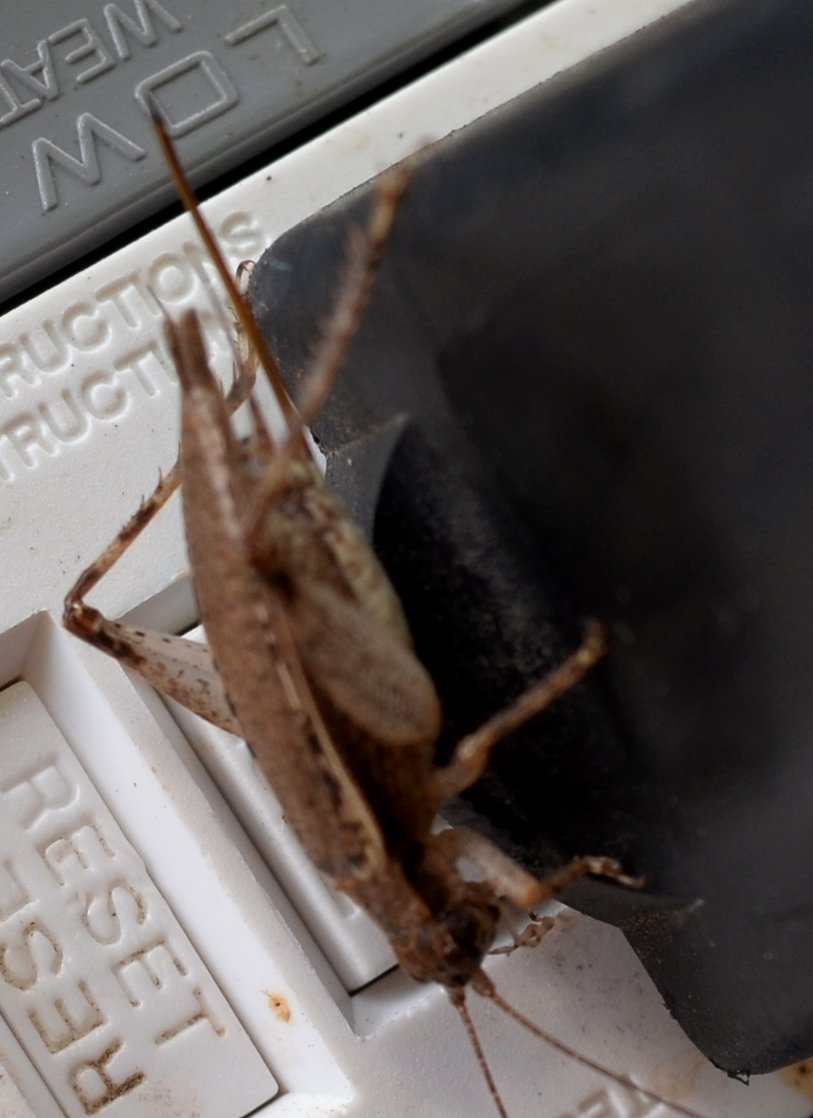
Now I think it's time to call on the spiders. Here is one the spiders that tend to hide in the flower end of the asters. It's the ghost spider - note its dark mouth region. But also note something else not an inch from the ghost. Crab spiders also stake out a tiny bit of territory in the active region of an aster. I wonder if this picture is not of TWO crab spiders looking for fun. This little common house spider seems at closer view to have caught a much bigger stink bug.

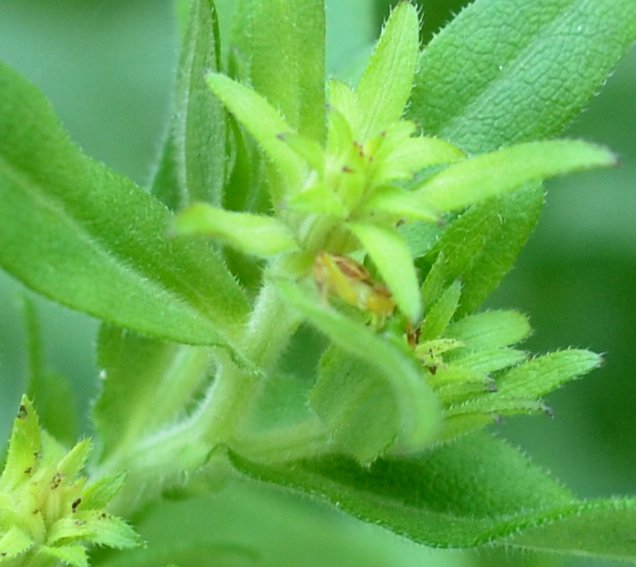
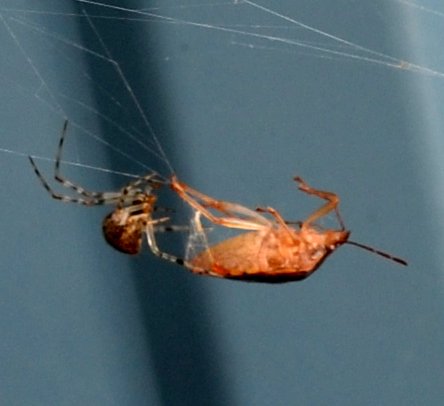
The grass spiders are probably the most visible spiders in the yard. They perch in plants near the central stalk, even when the leaves are mostly down. Their little sheet web is a great place for them to hide until some silly prey comes by, and then BAM! The prey is added to the debris in the nest, which will be disassembled later (the debris, that is).
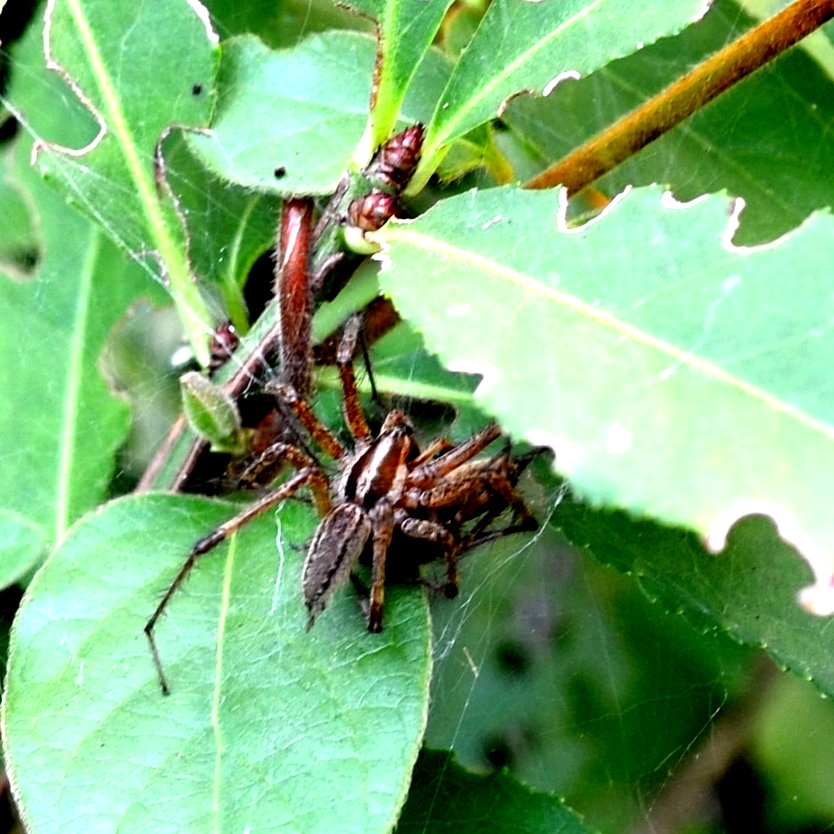
I would love to show you more wasp photos. But the fact is that I took TOO MANY photos of the wasps, not being a wise culler. I still need to identify more of them to go with the starts last time of a set of identified ones. But I'll end up now with just a few of the newer wasps. So here is one I didn't identify until I managed to get a photo of a wasp right next together time-wise with a good facial photo. This wasp that I couldn't stop taking pictures of is Vespula vidua (a so-called ground hornet) shown first from the back and next from the front, a side they don't like to show you because they do need to be ready to escape if you try anything funny. I'm going to end with this one of a genre I know you like: the naughty picture!



Oh, no. I have no self-stopping enzyme. I wait all year for the goldenrod to attract one of the most attractive wasps - the Northern Paper Wasp, Polistes fuscatus. The first one is the female, the next two are males. Number two - count the segments - seven for a boy, 6 for a girl. It's a male! Number three - look at that shield on its face: Male Polistes fuscata for sure! Remember these two rules for a male: 7 segments; shield design on the face.
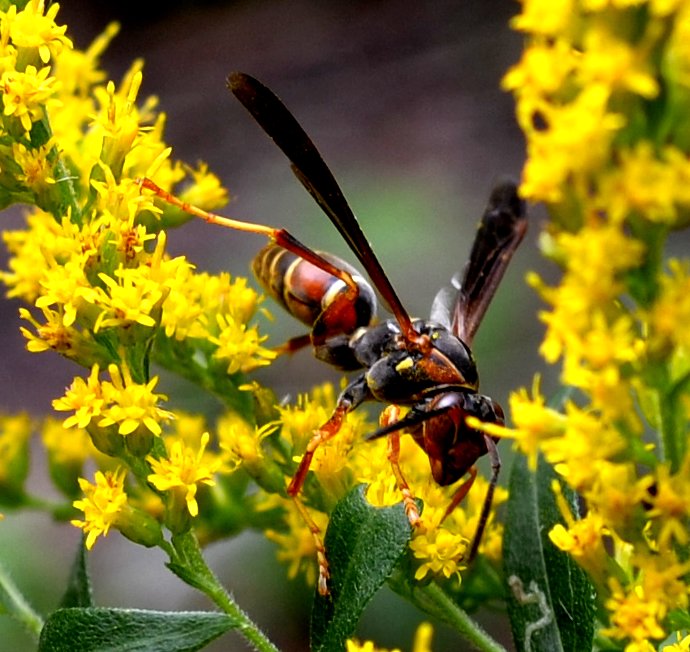
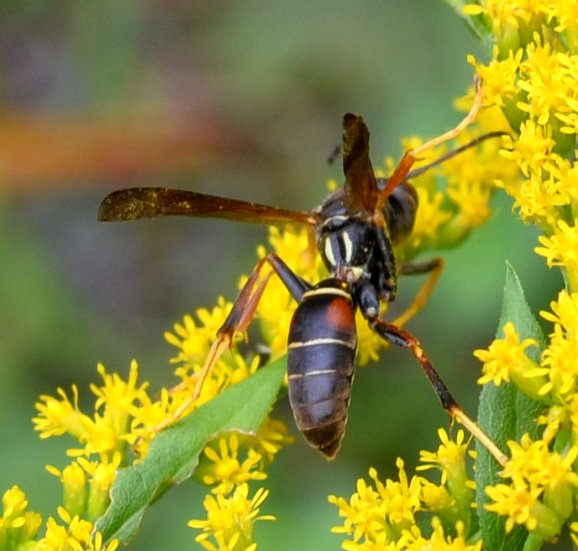
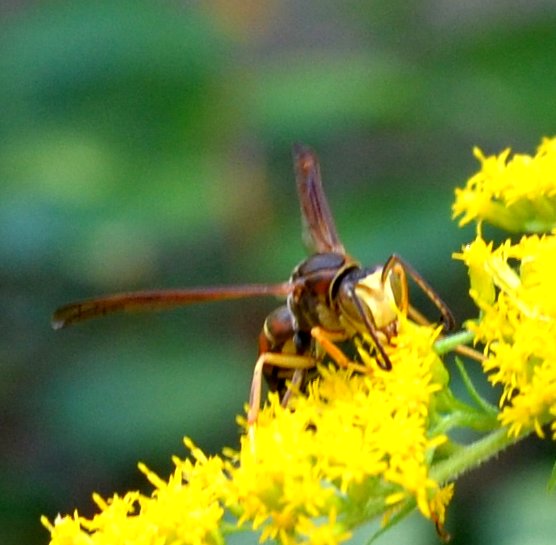
Let's end up with some more prettiness, as if those gorgeous wasps weren't the height of aesthetics! My favorite daylily, August Orange, still has a bit more blooming to do, but not much! I first saw these dayflowers, a two-petaled variation on the spiderwort, but we have them here too. Just leave a bit of ground disturbed, and it will find its way like a homing pigeon. Finally, the result of all that pollination of the trumpetvine by the bees and wasps, a pod full of seeds to start new plants with. Take my advice, don't just let them grow unless you really want a big arbor-like plant in about 20 years.

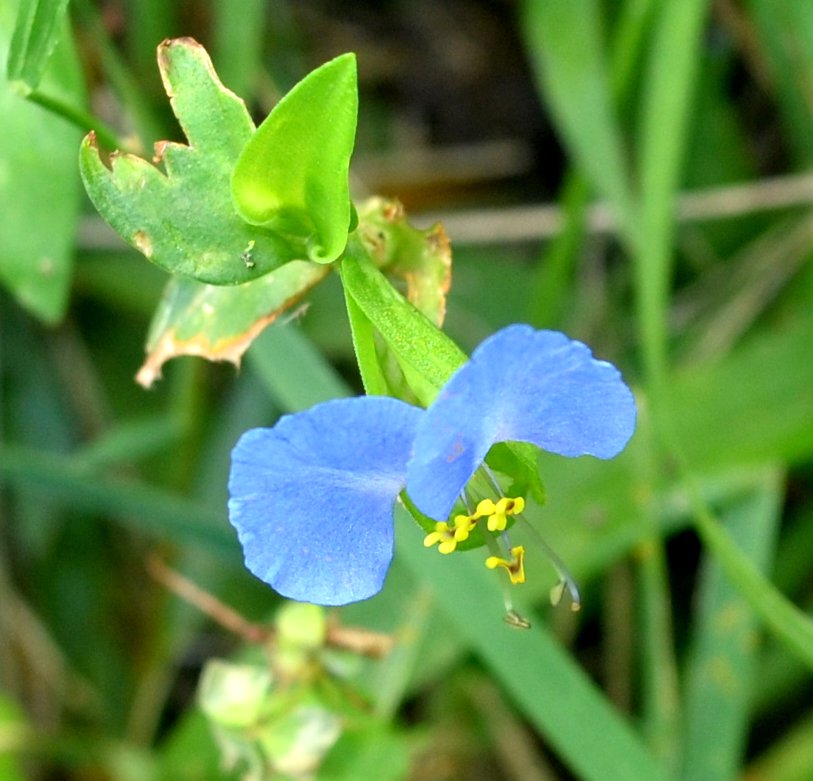
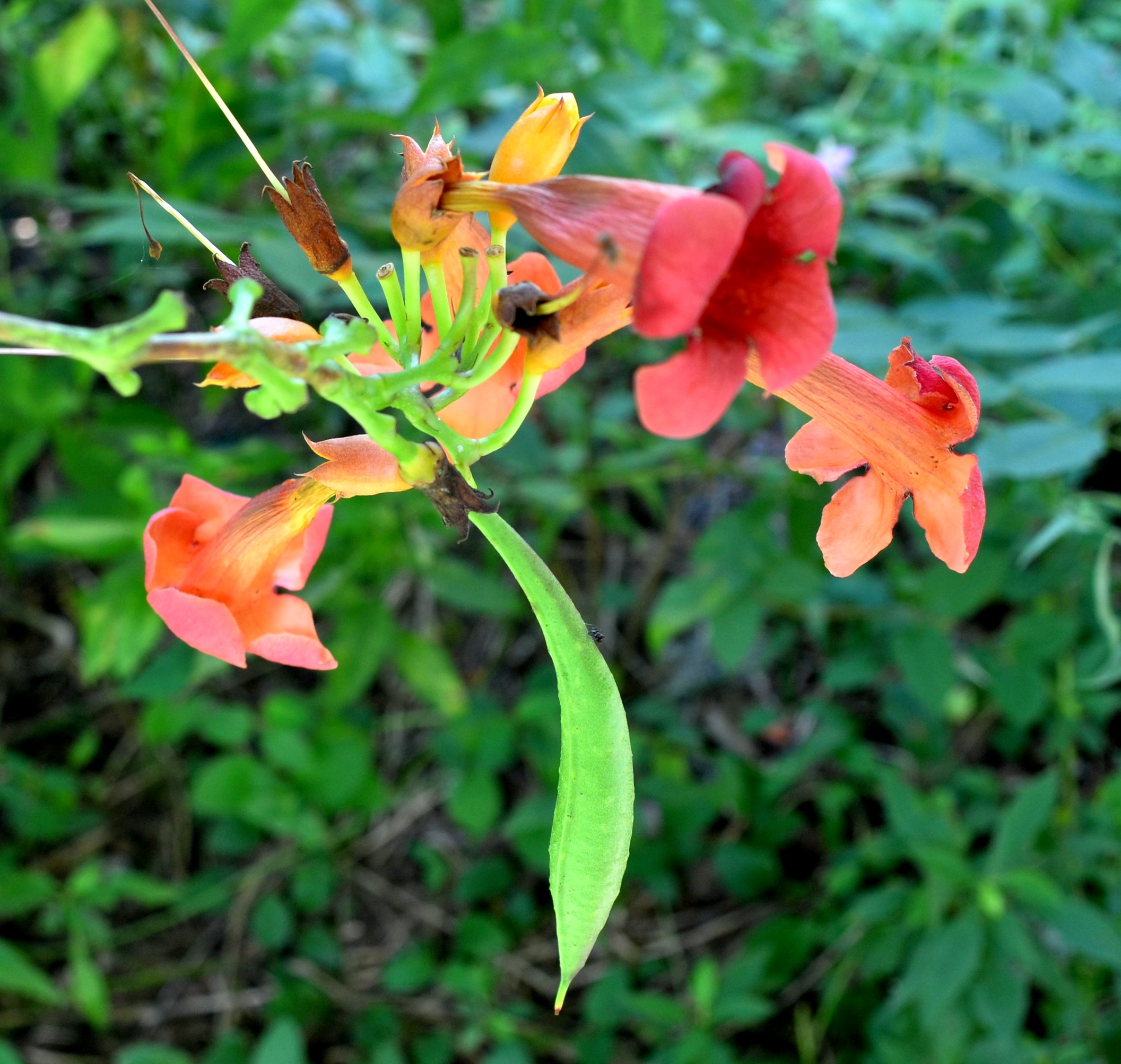
Hey, sorry this is late (only a day), there were so many beautiful scenes I overshot and had hours of extra cropping to do! Have a good week till we meet again.
Love, Martha
Back to September 4
On to September 18
Back to 2016 menu
Back to main menu
copyright Martha O'Kennon 2016

























 9 9 16 2.jpg)














































